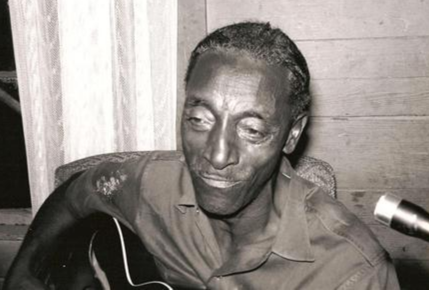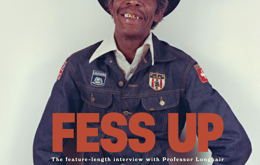Where would we be without the blues? Maybe right where we are now, in a blues-free zone: few traces of blues remain in most contemporary music. It was a far different story in the dear ol’ 20th century: you may remember it, or at least you’ve heard stories. In its first half blues was America’s foundational music, pulsing through everything from Tin Pan Alley pop tunes to jazz to early country and bluegrass. Yet a sense that blues, or some `pure’ form of it, anyway, had become endangered and needed rescue became a theme for a movement in the last third of the 20th century, one that still resonates.
Ironically blues seemed in fine fettle when this notion surfaced in the late `50s and early `60s. A Mississippi bluesman, Jimmy Reed, was scoring pop hits with songs everyone, including Elvis, later covered. English art school students were buying blues 45s released on Chicago’s Chess label, learning the songs and forming bands (notably the Rolling Stones) that would bring a version of Chicago blues into the pop mainstream. Yet in spite of the strong blues presence in that era’s pop music, a subculture felt the real blues was dying and, if it couldn’t be saved, it should at least be documented.
That’s where Alan Lomax came in. By 1959 he had a quarter century of field recording experience in his rear view mirror. He’d been at Angola Prison in 1933 when his father John discovered Lead Belly. He was the first to record Muddy Waters in 1941 at Mississippi’s Stovall’s Plantation. Lomax had one last great blues discovery to make. The story of that discovery is the subject of the film Shake `Em On Down.
Fred McDowell (circa 1906-1972) lived a sharecropper’s life in the north Mississippi hill country, a stark existence mitigated by the music making in which he was an exceptional participant. His talent might have gone uncelebrated beyond his remote community had not Alan Lomax and Shirley Collins been making field recordings in his area. McDowell heard they were recording at the home of a Como, MS. neighbor and dropped by. Collins recalls Fred being introduced and her feeling reluctant to `break the spell’ of the string band music played by brothers Miles and Bob Pratcher. But when he played, that quickly changed: “Fred started to play bottleneck guitar,” Collins wrote in her book, America Over the Water, “a shimmering and metallic sound. His singing was quiet but strong and with a heart-stopping intensity. By the time he’d finished his first blues, we knew we were in the presence of a great and extraordinary musician.”
Collins recalls that Sept. 21, 1959 revelation in the documentary Shake `Em On Down. There are also accounts of McDowell’s musical power and influence by Chris Strachwitz, who recorded him extensively for his Arhoolie label, and Bonnie Raitt, mentored by McDowell early in her career. Observations by musicologists like David Evans (“His music had a lot of qualities which essentially stem from African musical tradition”) are balanced by voices from McDowell’s community such as Cedric Burnside (“I like to call it feel music”).
There’s always a danger in `talking heads’-heavy documentaries of the constant contextualization overwhelming the content: if this guy was so great, why not just shut up and let him play? But filmmakers Joe York and Scott Barretta got the right talking heads to tell McDowell’s extraordinary story, and the balance of performance to explanation is well struck. Even the use of stock footage is nicely integrated: an account of his early life shows a pair of mules hauling a wagonload of cotton to a soundtrack of McDowell singing: “Lord, I worked ol’ Lou, Captain, Lord, and I worked ol’ Bell…”
McDowell was renowned around Como for his performance of “Shake `Em On Down,” a propulsive dance blues first recorded in 1937 by another slide guitar master, Bukka White. McDowell came to be called `Shake `Em On Down,” and, when Alan Lomax brought him to the 1964 Newport Folk Festival, he had McDowell play and sing that to demonstrate how blues had started as dance music. That performance opens the film of the same name, one that also includes a riveting performance from the 1965 American Folk Blues Festival, a package tour of blues greats that took McDowell to Europe. Despite international acclaim, McDowell worked as a pump jockey at a Stuckey’s till near the end of his life, when the Rolling Stones’ recording of his version of “You Got to Move” brought him substantial royalties.
The music and life of Fred McDowell are explored in an hour-long documentary, Shake `Em On Down. Until March 2, 2020, it’s free for the viewing online.
Kudos to film makers York and Barretta for citing, in their film’s credits, the inspiration of the 1969 Christian Garrison film, Blues Maker, which told McDowell’s story in a very different documentary style. It’s available on YouTube.
https://youtu.be/pBJ3E1d58CU
Recordings gleaned from Lomax’s 1959 Southern field trip appeared in 1961 on Atlantic, a label better known for jazz and R&B than for issuing folk material. But the urban `folk boom’ was on the rise, and Atlantic took a chance. The album, The Blues Roll On, introduced Fred McDowell, and may have in part inspired some young folk blues fans to try what Lomax had been doing for decades: search the South for `pure’ blues singers. They had specific artists in mind, and their journeys are explored in the film Two Trains Runnin’, in theatrical release earlier this year.
Director Samuel D. Pollard and screenwriter Benjamin Hedin weave the saga of young amateur folklorists into the tension and violence of the Freedom Summer in which they were unwittingly involved. Incongruously but effectively, the journey of feckless record collectors in pursuit of possible ghosts in the persons of Son House and Skip James is told as a kind of tragicomic thriller: one group from New York (“Three Jews in a Volkswagen with New York plates,” says Dick Waterman) in search of House; another, fronted by eccentric guitarist John Fahey, from California in search of the mysterious Skip James. On a different quest were three civil rights activists, also bound for Mississippi, their goal encouraging black voter registration. The film builds tension by following all three journeys (yes, we’re shown maps and moving lines indicating each group’s progress) to nearly the same geographic place. The action culminates in tragedy and triumph on June 21, 1964, the date when the Californians find an ailing Skip James, the New Yorkers get word that Son House is alive in Rochester, New York, and the three civil rights workers, two of them white, are murdered. The murders inspired outrage, while the rediscoveries led to second careers for two of the great pre-War blues artists. The confluence of time and place for journeys with such dissimilar goals and outcomes argues a kinship between the civil rights idealists and the folk blues enthusiasts, suggesting that what came to be called `the blues revival’ was part of a larger cultural moment.
Two Trains Runnin’ trailer
All that took place more than half a century ago in a far different world. One wonders what place our world has now for the blues. Perhaps your wall could use a little blues? For the 15th consecutive year, John Tefteller’s Blues Images has produced a handsome calendar illustrated by vintage advertisements for blues recordings accompanied by a CD of the advertised songs along with several others. Given the fantasy that some early blues artists existed in a remote world of folk purity, it’s revealing to see their work as the record companies saw them, as commercial products. Gimmicks were used to sell some records: the first blues release by Charley Patton was credited to the Masked Marvel. A 1929 ad for it shows a masked man in a tux and asks: “Who Is He? Guess His Correct Name and Win a Paramount Record.” Since Patton’s two prior releases had been gospel songs credited to Elder J.J. Hadley, it’s likely Paramount never paid off on that offer.
The best of these ads are effective commercial art vividly illustrating the songs they aimed to sell. The one for Blind Lemon Jefferson’s “Hot Dogs” shows him being collared by a cop as he tries to hoof it out a window. On the record, Jefferson speaks over his guitar about such a raid: “The law came and broke up that party. Everyone got away but me.” Obviously the artist hired to draw the ad had heard the record he was illustrating.
A couple of featured photos are also interesting, reportedly drawn from the estate of a Chicago photographer who photographed Mississippi blues singers in the 1930s. Few people may be excited by the first photo to be published of the Mississippi Moaner (real name: Isaiah Nettles), but to those of us who marvel at his “It’s Cold in China Blues,” it’s great to see. There’s a controversy about one of the photos in this year’s calendar, an advert for one of the first Memphis Minnie and Kansas Joe McCoy duets, “Frisco Town.” The couple pictured in the ad bears no resemblance to Minnie and McCoy from other photos, so they seem to have been, for unknown reasons, stand-ins.
Both evocative and provocative, the vintage ads are enhanced by the songs they aimed to hawk, offered on an accompanying CD with plenty more tunes than a year has months—the 2018 calendar has 24 songs comprising more than 70 minutes of music. This year’s CD offers both pre-War blues stars (Patton, Jefferson, ragtime guitar wizard Blind Blake) and the eccentric obscurities (Bo Weavil Jackson, `Hi’ Henry Brown, the aforementioned Mississippi Moaner) that tend to be show stealers on many vintage blues collections. As always Blues Images prides itself—with good reason–on the best possible sound quality: `Newly remastered from the finest copies of the original 78 rpm records,’ reads the banner on its CD back sleeve.
Anyone who has been listening to this music since the era of early reissue Lps can vouch for the superior sound quality Blues Images consistently provides. A prime example is Tommy Johnson’s 1929 Paramount recording, “Slidin’ Delta.” I’d heard it once on a reissue in which it sounded as if it had been recorded in a Quonset hut in a hailstorm (actually a lot of early Paramount reissues sounded like that). “Slidin’ Delta” will never sound as good as Johnson’s Victor sides, which were better recorded in the first place, but this is a dramatic improvement. And another feature of Blues Images CDs is a lost side or two recovered. This year it’s the Memphis Jug Band’s “Poor Jab Blues” and “My Love Is Cold.” If you’re hot for vintage blues, you’ll want Blues Images 2018 calendar (Vol. 15). It’s available online here.
 Baja Review A community newspaper serving Ensenada, Valle de Guadalupe, and Rosarito in Northern Baja California
Baja Review A community newspaper serving Ensenada, Valle de Guadalupe, and Rosarito in Northern Baja California





